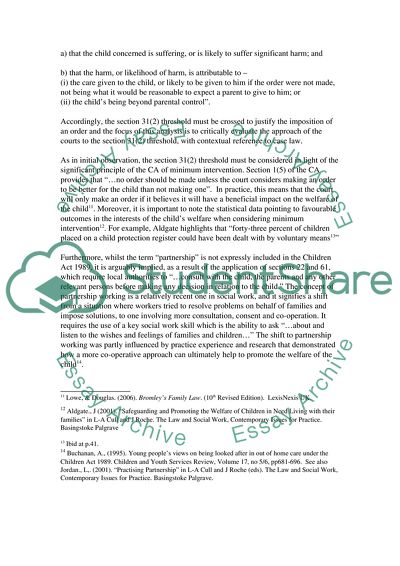Cite this document
(How the Courts Have Interpreted the Requirements Of Section 31 of the Assignment, n.d.)
How the Courts Have Interpreted the Requirements Of Section 31 of the Assignment. Retrieved from https://studentshare.org/law/1719971-the-children-act-1989-made-important-changes-about-the-criteria-used-to-decide-whether-a-child-should-be-taken-into-care-with-reference-to-decided-cases-discuss-how-the-courts-have-interpreted-the-requirements-of-s312-of-the-children-act-1989
How the Courts Have Interpreted the Requirements Of Section 31 of the Assignment. Retrieved from https://studentshare.org/law/1719971-the-children-act-1989-made-important-changes-about-the-criteria-used-to-decide-whether-a-child-should-be-taken-into-care-with-reference-to-decided-cases-discuss-how-the-courts-have-interpreted-the-requirements-of-s312-of-the-children-act-1989
(How the Courts Have Interpreted the Requirements Of Section 31 of the Assignment)
How the Courts Have Interpreted the Requirements Of Section 31 of the Assignment. https://studentshare.org/law/1719971-the-children-act-1989-made-important-changes-about-the-criteria-used-to-decide-whether-a-child-should-be-taken-into-care-with-reference-to-decided-cases-discuss-how-the-courts-have-interpreted-the-requirements-of-s312-of-the-children-act-1989.
How the Courts Have Interpreted the Requirements Of Section 31 of the Assignment. https://studentshare.org/law/1719971-the-children-act-1989-made-important-changes-about-the-criteria-used-to-decide-whether-a-child-should-be-taken-into-care-with-reference-to-decided-cases-discuss-how-the-courts-have-interpreted-the-requirements-of-s312-of-the-children-act-1989.
“How the Courts Have Interpreted the Requirements Of Section 31 of the Assignment”, n.d. https://studentshare.org/law/1719971-the-children-act-1989-made-important-changes-about-the-criteria-used-to-decide-whether-a-child-should-be-taken-into-care-with-reference-to-decided-cases-discuss-how-the-courts-have-interpreted-the-requirements-of-s312-of-the-children-act-1989.


